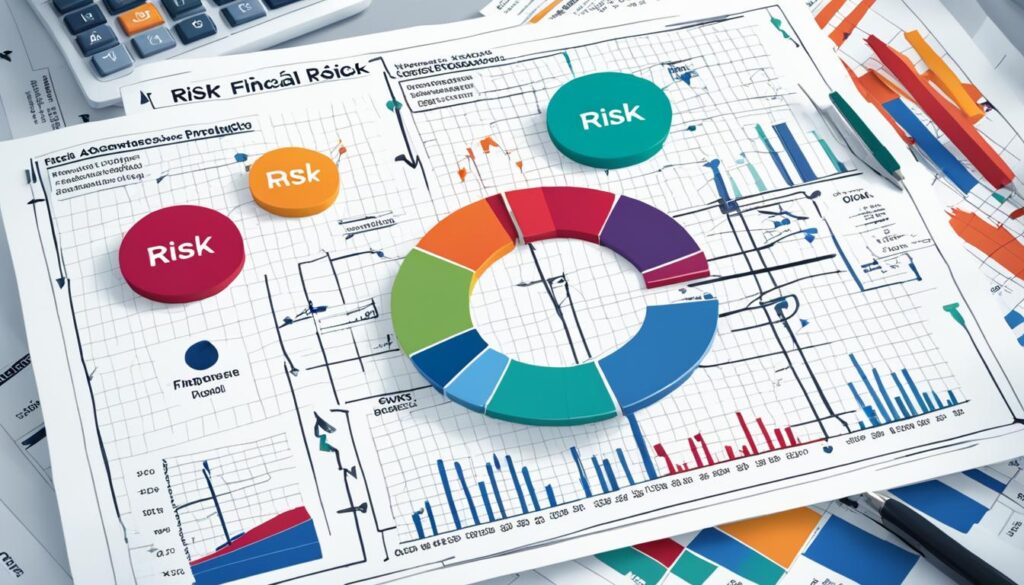As an avid observer and participant in the realm of corporate finance risk management, I’ve come to firmly grasp the critical nature of financial risk management within the corporate sector. This intricate dance of assessing potential investment uncertainties and aligning them with the right risk management strategies forms the backbone of a sound financial foundation for any business.
In my experience, embracing this discipline involves a complex blend of foresight, analytics, and strategic maneuvering, ensuring that businesses not only survive but thrive amidst a sea of fiscal unpredictability. Spanning methods such as risk avoidance, retention, sharing, transferring, and loss reduction, each risk management strategy is carefully chosen to align with the organization’s risk tolerance and financial goals, aiming to mitigate the impact of potential losses.
At the core of my financial arsenal lies the use of standard deviation—a powerful statistical tool that provides valuable insights into the variability of investment returns. Standard deviation serves as my compass for navigating through the volatile waters of portfolio management, enabling me to quantify risk and make well-informed decisions under the umbrella of financial risk management.
Table of Contents
ToggleKey Takeaways
- Risk management in corporate finance is paramount for protecting the fiscal health of a company.
- Effective financial risk management strategies help balance potential returns with associated risks.
- Identifying, analyzing, and prioritizing risks are foundational steps in developing a risk management plan.
- Utilizing tools such as standard deviation enables quantification and handling of investment volatility.
- Strategic application of risk management methods supports a company’s financial objectives and tolerance against losses.
The Essence of Risk Management in Corporate Finance
At the core of a thriving enterprise lies the adeptness to navigate financial uncertainties—a testament to the potency of a comprehensive risk management framework. My exploration into this pivotal aspect of corporate finance reveals an intricate dance with chance, where every step towards managing risks not only protects, but also propels businesses towards their fiscal aspirations.
Understanding the Fundamentals of Financial Risk
My journey begins with probing the depth of financial risk, an omnipresent companion of investment returns. It’s an unbidden player, offering both promising advances and cautionary tales. Through methodical risk identification and assessment, I discern its multifaceted nature and categorize potential threats, laying the groundwork for strategic defense mechanisms.
Strategies for Mitigating Uncertainty in Investments
Venturing further, I encounter myriad strategies to temper the fickle whispers of uncertainty. From the straightforward path of avoidance to the stoic stance of retention and into the communal haven of sharing, I navigate the tactics with keen insight. In transferring and loss prevention, I find allies in risk management techniques that arm investors and corporations against potential adversities.
The Interplay Between Risk and Return
The interlude between risk and return is where the profound revelations of my inquiry crystallize. Grappling with volatility, I am reminded that while increased risk may court increased returns, sagacity demands equilibrium. Diversification, asset allocation—these are the instruments in my repertoire, played with discernment to balance these inexorable forces and fulfill the promise of financial ambitions.
Risk Identification and Assessment
The cornerstone of robust financial risk management strategies lies in the early identification and precise assessment of potential financial threats. This proactive stance in risk management procedures paves the way for crafting informed responses designed to safeguard investments and operations against adverse outcomes. With the use of advanced risk management tools, I meticulously catalog and evaluate risks to ensure our strategies are not only reactive but also preventive in nature.
Methods of Identifying Potential Financial Threats
My methods begin with a comprehensive brainstorming process, where every conceivable uncertainty is brought to the table. These potential threats are then documented in order of priority, setting the stage for deeper analysis. Such systematic flagging is crucial for the preemptive detection of risks that could impact our financial goals.
Assessment Techniques for Evaluating Risk Severity
Assessment techniques are multifaceted, incorporating the latest diagnostics to dive into the genesis and potential ramifications of each identified risk. My approach is anything but superficial; it is an incisive probe aimed at demystifying both the probability and impact of the risks, thus shaping the blueprint of our response strategy.
| Risk Category | Identification Method | Assessment Technique | Example Financial Threat |
|---|---|---|---|
| Market Risk | Economic Indicators Analysis | Value at Risk (VaR) Models | Interest Rate Fluctuations |
| Credit Risk | Credit Rating Reviews | Stress Testing | Default on Corporate Bonds |
| Liquidity Risk | Cash Flow Projections | Scenario Analysis | Emergency Funding Needs |
| Operational Risk | Process Audits | Cause-Effect Analysis | System Outages |

The echoed theme in my quest for financial risk management is clear: vigilance and diligence. By maintaining these as my modi operandi, my strategies are geared toward not merely reacting to risks, but forestalling them to retain a competitive edge in the volatile domain of corporate finance.
Sophisticated Risk Management Tools
In my exploration of risk management strategies, it has become increasingly clear how pivotal sophisticated tools are in the realm of financial risk management. Engaging with advanced analytical methods grants me a deepened perspective on risk and enhances my ability to predict and mitigate financial uncertainties. These instruments and strategies are fundamental to achieving a robust risk mitigation in finance.
Financial instruments like options and futures stand out as some of the more complex tools at my disposal. They allow for a nuanced approach in managing risk exposure. Additionally, statistical measures, including standard deviation, are indispensable for assessing the variability of an asset’s returns in relation to its risk profile.
- Options and Futures: Facilitate hedging against market movements and price volatility.
- Positional Sizing: Helps balance the risk in the portfolio according to the risk tolerance.
- Portfolio Diversification: Spreads investment across various asset classes to mitigate unsystematic risk.
The integration of these tools into my financial toolkit enhances my decision-making process, ensuring that I am not only reactive to market dynamics but also proactively shaping my investment landscape. Here’s a glimpse into how I leverage these tools in the decision-making framework:
| Tool | Purpose | Outcome |
|---|---|---|
| Options Contracts | Risk transfer mechanism through right to buy/sell at predetermined prices | Hedged position with limited downside risk |
| Futures Contracts | Commitment to buy/sell asset at a future date at an agreed-upon price | Price certainty against market fluctuations |
| Standard Deviation | Measure variability of returns for a given investment | Informed decisions aligned with risk tolerance |
To illustrate the confluence of these tools within an investment context, consider the following scenario:
“Utilizing options, I can construct a protective put strategy to guarantee a minimum sale price for my stocks, thereby locking in potential profits and capping losses. Through futures, I engage in short selling to bet on anticipated market downturns while deploying standard deviation to gauge the expected range of movement – a critical step in aligning my investments with my predisposition for risk.”

This calculated and empirical approach exemplifies how embracing complexity and nuance in financial tools is not merely optional but necessary. It underscores my commitment to a disciplined risk management philosophy, ensuring that my financial goals remain within reach amidst a fluctuating economic landscape.
Implementing a Robust Risk Management Framework
As I consider the roots of a sturdy risk management framework, I’m instantly reminded of its structural integrity. This is built on the foundation of detailed strategic planning, meticulous organization, committed cost control, and thorough budgeting. Each aspect is crucial and operates as a pivotal post against the unpredictable storms of financial uncertainties. It’s this kind of steadfast groundwork that transforms risk management from a mere concept into tangible, actionable methodologies.
Key Components of an Effective Risk Management System
Breaking down the key components, I recognize strategic planning as the blueprint for risk management. It sets the direction and prepares the terrain. Organization, akin to the framework’s steel beams, provides structure and order to the plan. Moreover, cost control is the tight surveillance over resources, ensuring nothing hemorrhages value unnecessarily. Finally, the budgeting process acts as the financial compass, keeping the entire system on course to avoid fiscal misadventures. Combined, these elements create an incisive approach to risk mitigation that can adapt and endure over time.

Integrating Risk Management into Corporate Strategy
To me, truly effective risk management techniques are woven into the very fabric of corporate strategy. This is where risk identification and assessment become not just reactive tasks, but proactive inputs into decision-making. Integrating risk management into the broader corporate narrative means ensuring that as objectives arc upwards, the safety net of risk assessment and mitigation spreads out beneath. It’s the harmonizing of aims and safeguards so that every leap forward is calculated and confident.
Risk Management Procedures in Corporate Finance
Within the realm of corporate finance, the establishment and adherence to systematic risk management procedures seem not only prudent but also essential for a firm’s sustainability. These procedures encompass a broad spectrum of practices, designed to fortify a company’s resilience against financial threats.
Procedural Steps for Risk Control and Mitigation
My engagement in corporate finance has consistently underscored the importance of structured protocols for effectuating risk control and mitigation. This meticulous process involves a series of strategic steps that seamlessly combine to form a robust defense against financial volatilities:
- Initial Risk Identification: Here’s where we scour the financial landscape, identifying potential risks that could impact the firm.
- Comprehensive Risk Assessment: Following the identification is an analytical phase where each risk is meticulously scrutinized in terms of potential impact and likelihood.
- Strategy Formulation: Subsequently, we craft tailored response strategies based on the prior assessment, readying our arsenal to face the identified risks head-on.
- Action Plan Implementation: With strategies in place, we advance into the execution stage, proactively applying risk management tools to mitigate the threats.
- Continuous Monitoring and Review: Risk management is an ongoing battle; thus, constant vigilance and periodic reviewing of strategies are imperative for staying ahead of risks.
Documenting and Reporting for Transparency
Integral to risk management procedures is the pivotal role of documenting and reporting. This phase ensures an unwavering transparency that not only builds trust with stakeholders but also serves as a beacon, guiding the perpetual refinement of our risk management strategies:
| Documentation Aspects | Functions | Benefits |
|---|---|---|
| Risk Registers | Tracking Identified Risks | Provides a detailed record for reference and analysis |
| Assessment Records | Detailing Risk Evaluations | Facilitates understanding of risk severity and response adequacy |
| Strategy Documentation | Outlining Response Plans | Ensures strategic alignment and clarity in execution |
| Status Reports | Monitoring Progress | Keeps stakeholders informed and involved in the risk management process |
| Review Summaries | Capturing Updates and Revisions | Encourages adaptive strategies and dynamic responses |
Therefore, incorporating streamlined risk management procedures, leveraging effective risk management tools, and firmly embedding this ethos into the company’s operations, I ensure comprehensive coverage against the financial risks that the contemporary corporate world presents.

Financial Risk Management: Strategies and Tactics
Understanding the nuances of financial risk management is central to my practice as a professional in the field. My engagement with risk management strategies stems from their critical role in the stewardship of any organization’s financial health. These strategies, when woven into a robust risk management framework, empower businesses with the foresight to navigate volatile economic landscapes.
Risk avoidance, for example, is a strategy aimed at sidestepping potential losses by not engaging in risky activities or investments. In contrast, risk reduction involves taking proactive measures to diminish the negative impact of financial threats. Risk transfer, typically through insurance policies or hedging contracts, shifts the burden of potential losses to a third party. Lastly, risk retention is a conscious choice made by an organization when it decides to absorb the losses from identified risks, often due to cost-benefit calculations.
Each strategy is selected based on its appropriateness for the situation at hand and the corporation’s risk tolerance. My expertise allows me to evaluate which strategy aligns best with an organization’s unique financial risk profile—a process that is both analytical and deeply consultative.
When I confront the myriad of risks in the market, including credit, market, operational, and liquidity risks, molding the chosen strategies to tackle these financial threats is akin to constructing a tailored suit. It must fit the company’s contours perfectly to offer the necessary protection and enable it to meet its financial goals.
Here’s a succinct breakdown of key tactics under each strategic category:
- Risk Avoidance: Ceasing high-risk activities, selective project participation.
- Risk Reduction: Diversifying investments, enhancing internal controls.
- Risk Transfer: Purchasing insurance, entering derivatives contracts.
- Risk Retention: Establishing reserve funds, accepting manageable losses.
For me, financial risk management is the art and science of decision-making. It is about crafting and executing a plan that not only mitigates risks but also positions an organization for sustainable growth and success. The blend of strategic choices and tactical approaches must continue to evolve, as the dynamism of the financial markets never wanes.
Risk Mitigation in Finance: Sharing and Transference
In the landscape of financial risk management, it is my understanding that not all risks should be shouldered alone. The strategies of sharing and transferring risks are crucial aspects of risk mitigation in finance. These methods serve as a buffer against potential financial pitfalls, ensuring that a well-balanced portfolio can withstand the systemic shocks that occasionally rattle the markets.
Understanding the Role of Diversification
Diversification is one of the most widely advocated risk management techniques. By spreading investments across different asset classes and sectors, I am able to dilute the impact of an underperforming investment on my overall portfolio. This practice effectively reduces unsystematic risk, which is specific to a company or industry, and therefore, is a critical component in fortifying my financial position against unexpected market movements.
Insurance and Hedging: Transferring Risks Effectively
Risk transfer is another cornerstone in the architecture of risk mitigation in finance. Insurance and hedging are two prominent methods that aid in this process. Insurance policies offer peace of mind, transferring the financial burden of potential losses to the insurer. On the other hand, hedging involves taking an offsetting position in a related security, such as derivatives, to counterbalance potential losses. These strategies are pivotal in safeguarding a firm’s or individual’s assets, ensuring continuity and stability.
| Risk Management Strategy | Objective | Tools/Instruments |
|---|---|---|
| Diversification | To reduce unsystematic risk | Mix of asset classes |
| Insurance | To transfer risk of loss | Insurance policies |
| Hedging | To mitigate exposure to price movements | Derivatives (e.g., futures, options) |
My commitment to risk management is unyielding, as I continuously strive to implement diverse strategies that not only mitigate financial risks but also align with my long-term objectives. In embracing diversification, insurance, and hedging, I am equipped to navigate the financial markets with deft and resolve. These methods are not merely a safety net but an integral component of a robust financial strategy.
Risk Reduction Techniques and Loss Prevention
In my journey with financial risk management, the deployment of effective risk reduction techniques is paramount to a robust risk management framework. Strategic planning is not just about outlining future steps but is a bulwark against financial upheaval, much like a seawall against the tides of unpredictability in the market. The focus of this section hones in on loss prevention and how diligent preparation and active mitigation measures fortify a business’s resilience.
Loss Prevention Through Strategic Planning
To preemptively confront potential setbacks, strategic planning within the risk management framework is executed with precision. For instance, scenario analysis—a powerful forecasting tool— allows me to anticipate a range of outcomes from financial decisions, guiding my approach to navigating risks and capitalizing on opportunities with heightened awareness and preparedness.
Safeguarding Assets with Diligent Risk Reduction
In striving to safeguard assets, my approach to risk reduction techniques is methodical and thorough. Measures like regular audits and controls are pivotal in detecting vulnerabilities early on, cementing a trust in operational integrity. Hedging, as a strategic financial risk management technique, offers a shield, particularly against price volatility in commodity-driven businesses, maintaining the equilibrium of financial footing.
| Risk Reduction Tactics | Benefits | Implementation in Asset Protection |
|---|---|---|
| Regular Financial Audits | Early Detection of Irregularities | Assurance of Resourced Allocation Integrity |
| Scenario Analysis | Preparedness for Diverse Financial Outcomes | Strategic Adaptability to Market Changes |
| Hedging Strategies | Mitigation of Price Volatility Exposure | Stability in Commodity Sensitive Operations |
Conclusion
In wrapping up the discourse on risk management in corporate finance, it’s clear that the journey to protect and enhance the financial health of a business is intricate and replete with challenges. As we grapple with the various complexities, from the inception of risk identification to the deployment of intricate mitigation tactics, it becomes evident that the marriage of vigilance and strategy is pivotal. My experiences and insights into corporate finance risk management strategies have fortified my belief that a business’s longevity is deeply rooted in how well it can forecast, evaluate, and respond to ever-changing financial uncertainties.
There is an undeniable synergy between the utilization of a risk management framework and the attainment of fiscal prudence. By weaving together a tapestry of analytical tools, advanced models, and strategic planning, businesses stand not just to weather the proverbial financial storms but to also chart a course towards sustainable growth and success. The act of balancing risk and reward, after all, is not merely a monetary endeavor but an underpinning philosophy that shapes the ethos of prudent financial stewardship.
Therefore, I hold steadfast in my assertion that risk management transcends the bounds of a mere corporate obligation—it is the lifeblood that ensures a company’s resilience and dynamism amidst the ebbs and flows of global finance. It is with this understanding that corporations can not only safeguard their assets but also confidently pursue innovation and expansion, fully aware that their risk management infrastructure provides a sturdy bulwark against potential fiscal pitfalls.
FAQ
What is the purpose of risk management in corporate finance?
The purpose of risk management in corporate finance is to identify, analyze, and address uncertainties that affect investment decisions and company finances, with a goal of safeguarding the company’s fiscal objectives and tolerances against potential losses.
How do financial risks impact investment returns?
Financial risks are an intrinsic part of investment returns, presenting both opportunities and costs. High financial risks can lead to increased volatility and potential for higher returns, but they also raise the chance of significant losses.
What are some common strategies for mitigating uncertainty in investments?
Common strategies include risk avoidance, risk retention, risk sharing, risk transferring, and loss prevention and reduction. These strategies help investors and companies minimize the impact of financial uncertainties on their portfolios and balance sheets.
How do you effectively identify and assess financial risks?
Effectively identifying and assessing financial risks involves a systematic process that includes brainstorming sessions to identify uncertainties, prioritizing risks, and employing problem-solving and diagnostic tools to understand their root causes and potential impact.
Can you describe some sophisticated risk management tools?
Sophisticated risk management tools include statistical measures like standard deviation, advanced investment models, and financial instruments such as options and futures that help empirically assess and hedge risks.
What are some key components of an effective risk management system?
Key components include strategic planning, organization, cost control, and budgeting. An effective system should also be integrated into the company’s corporate strategy to ensure alignment with overall objectives.
What does integrating risk management into corporate strategy involve?
Integrating risk management into corporate strategy involves considering potential risks in every business decision and aligning them with the company’s goals. It ensures a proactive stance in dealing with risks and contributes to long-term growth and stability.
What procedural steps are involved in risk control and mitigation?
Procedural steps for risk control and mitigation include preparation, risk assessment, developing response strategies, execution of mitigation tactics, and continuous review and improvement of the processes.
Why is documentation and reporting important in risk management?
Documentation and reporting are vital for maintaining transparency, tracking and analyzing risks, and ensuring continuous improvement in the risk management processes, thus building trust among stakeholders.
What risk management strategies are used to handle financial threats?
Strategies to handle financial threats include risk avoidance, risk reduction, risk transfer, and risk retention. The optimal choice depends on the organization’s risk appetite and the specific financial scenario it is facing.
How does risk mitigation in finance utilize sharing and transference?
Risk mitigation in finance uses sharing and transference to minimize specific risks. Sharing can occur via diversification, while transference often involves insurance and hedging to move the risk to another party, such as an insurer or other financial entities.
What role does diversification play in risk management?
Diversification plays a central role in reducing unsystematic risk by spreading investments across various asset classes, thereby minimizing the impact of a single asset’s poor performance on the overall portfolio.
How can insurance and hedging help in financial risk management?
Insurance and hedging help in financial risk management by transferring risk to third parties, thus shielding a company from potential financial losses due to unforeseen events and providing stability.
What are loss prevention and risk reduction techniques in risk management?
Loss prevention and risk reduction techniques include creating strategic plans to confront potential business interruptions promptly. These techniques aim to minimize losses, prevent risks from spreading, and maintain operational integrity.
How can a company safeguard assets through diligent risk reduction?
A company can safeguard assets through diligent risk reduction by implementing strategies like hedging against price fluctuations, improving security measures to protect against theft and damage, and optimizing operational processes to prevent loss.











